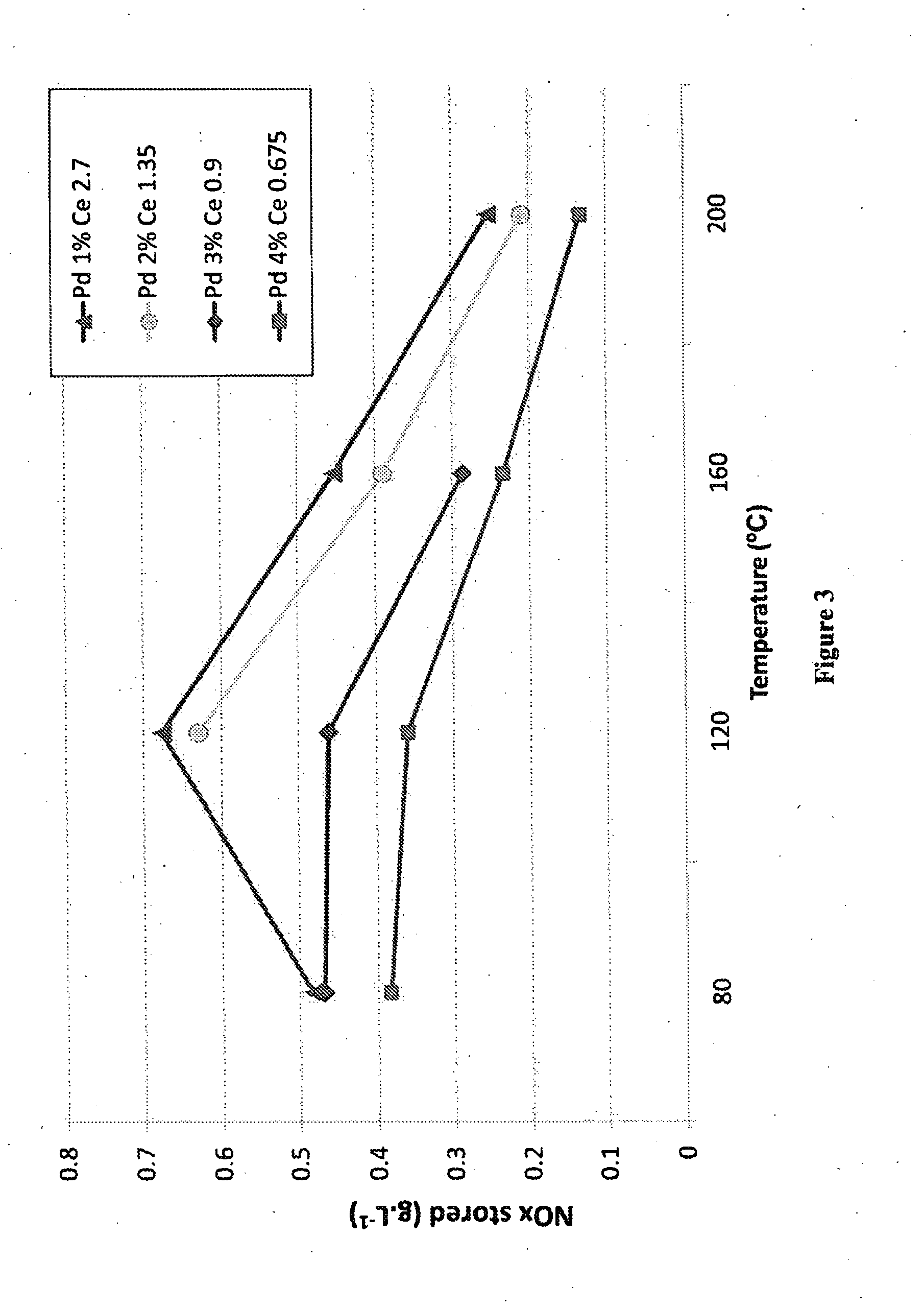Oxidation Catalyst for a Compression Ignition Engine
a technology of oxidation catalyst and compression ignition engine, which is applied in the direction of metal/metal-oxide/metal-hydroxide catalyst, machine/engine, arsenic compound, etc., can solve the problems of more susceptible to sulfur poisoning of palladium, and achieve the effect of reducing or preventing production of n2o
- Summary
- Abstract
- Description
- Claims
- Application Information
AI Technical Summary
Benefits of technology
Problems solved by technology
Method used
Image
Examples
example 1
[0217]Palladium nitrate was added to a slurry of ceria in water. The slurry containing palladium nitrate was stirred to homogenise then coated onto a metallic substrate with 300 cells per square inch using conventional coating techniques to form a first layer. The coated part was dried and calcined at 500° C.
[0218]A second slurry was prepared by taking alumina powder and milling to a particle size where the d90 was less than 20 micron. Soluble platinum and palladium salts were added and the resulting slurry was stirred to homogenise. This second slurry was coated on to the part using conventional coating techniques to form a second layer. The part was dried and calcined at 500° C.
[0219]The resulting catalyst had a total loading of platinum and palladium (i.e. the total PGM loading in both layers) of 160 g / ft3 and the total mass ratio (i.e. both layers) of Pt:Pd was 5:11.
example 2
[0220]An alumina slurry was prepared using an alumina powder that had been milled to a particle size where the d90 was less than 20 micron. Soluble platinum and palladium salts were added and the resulting slurry was stirred to homogenise. This slurry was then coated on to a metallic substrate with 300 cells per square inch using conventional coating techniques to form a first layer. The part was dried and calcined at 500° C.
[0221]Palladium nitrate was added to a slurry of ceria in water. This second slurry containing palladium nitrate was stirred to homogenise and was then coated onto the part using conventional coating techniques to form a second layer. The coated part was dried and calcined at 500° C.
[0222]The resulting catalyst had a total loading of platinum and palladium (i.e. the total PGM loading in both layers) of 160 g / ft3 and the total mass ratio (i.e. both layers) of Pt:Pd was 5:11.
Experimental Results
[0223]The catalysts of Examples 1 and 2 were hydrothermally aged at 80...
examples 3 to 5
[0226]Palladium nitrate was added to a slurry of ceria in water. The slurry containing the palladium nitrate was stirred to homogenise and then coated onto a ceramic substrate using conventional coating techniques. The coated part was dried and calcined at 500° C.
[0227]The loading of ceria was 2.7 g in−3 (Examples 3 to 5). The loading of palladium as a percentage of the loading of ceria was varied as follows: 1 wt % (Example 3); 2 wt % (Example 4); 4 wt % (Example 5). Each aft coated parts was hydrothermally aged at 750° C. for 15 hours.
Experimental Results
[0228]A 1×3″ core sample from each of the catalysts of Examples 3, 4 and 5 was taken and tested on a synthetic gas rig. The gas mix that was used to perform the tests is shown in Table 2 below.
TABLE 2GasAmountNO100 ppmCO500 ppmCO24.5%H2O 5%O2 12%N2Balance
[0229]Each of the core samples was brought up to 80° C. and then exposed to the gas mix in Table 2 for 10 minutes with the aim of storing NOx. The gas mix was then switched to ni...
PUM
| Property | Measurement | Unit |
|---|---|---|
| particle size | aaaaa | aaaaa |
| weight | aaaaa | aaaaa |
| weight | aaaaa | aaaaa |
Abstract
Description
Claims
Application Information
 Login to view more
Login to view more - R&D Engineer
- R&D Manager
- IP Professional
- Industry Leading Data Capabilities
- Powerful AI technology
- Patent DNA Extraction
Browse by: Latest US Patents, China's latest patents, Technical Efficacy Thesaurus, Application Domain, Technology Topic.
© 2024 PatSnap. All rights reserved.Legal|Privacy policy|Modern Slavery Act Transparency Statement|Sitemap



